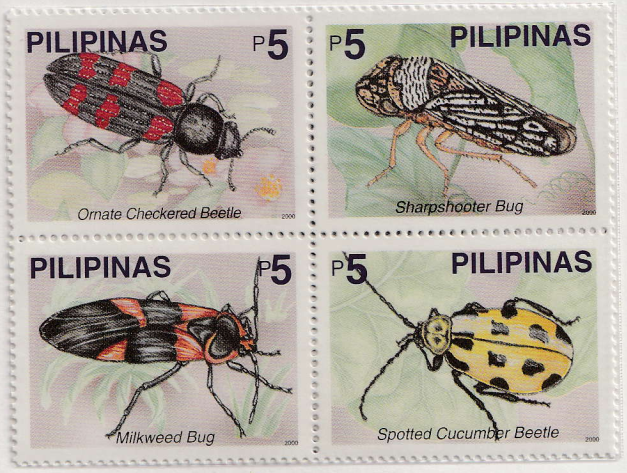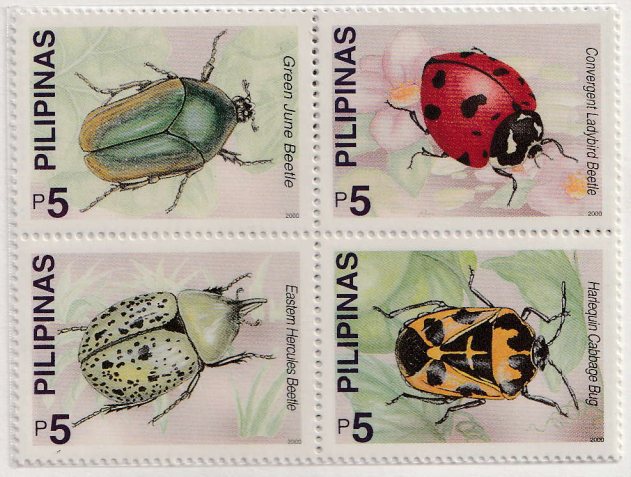Trivia about Insects of the Philippines
1. Ornate Checkered Beetle – Feeds on wasp and bee larvae. Ham Beetles are scavengers and feed on carrion and blowfly larvae; they may also be pests on smoked meats. Small, brightly colored, patterned or checkered beetles with hairy, elongated bodies and rather soft elytra. They have large heads and clubbed antennae. Most common in woodland, on flowers and trees, usually on or under the bark or on the flowers, not on the leaves. Feed on pollen or on the larvae and adults of bark-boring beetles.
Many larvae live in the galleries of beetles, where they hunt for the larvae of the bark beetles. Others attack the larvae of gallforming beetles or of bees and wasps. Some feed on moth caterpillars. A few feed on stored meats.
2. Sharpshooter Bug – Mostly small insects with two pairs of !similar membranous wings (i.e. homopterous) or wingless. Wings often held in a roof-like position over the body when at rest. All have sucking mouth parts which originate far back beneath the head.
All feed on plants, sucking out their juices with their sucking mouth parts. They may be found on any part of a plant, from roots to leaves, stems, flowers and fruits.
Nymphs similar in form to adults but wingless. Life cycle may be normal with nymphs developing through several molts into adults, or may involve alternation of winged and wingless forms, as in aphids.
3. Milkweed Bug – Are brightly colored bugs and used in laboratories. Very diverse group of elongated or oval, hard-bodied bugs; many are dull brown or yellow but others are strikingly colored. They have only five distinct veins in the membranous area of each fore wing.
Most feed on the seeds of grasses and other plants or suck plant juices; some prey on other insects. They are found in meadows, fields and crops, especially amongst grasses.
4. Spotted Cucumber Beetle – A large family and probably the most damaging beetle family. Small, oval and convex in outline. These beetles are often metallic in appearance and attractively marked with various colors. Antennae short, less than half the length of the body, thread-like, clubbed or saw-toothed. Eyes not notched. Found on all kinds of native plants, crops and trees, often together with their larvae. They feed on leaves, pollen and flowers.
5. Green June Beetle – Is a large robust beetle, found on flowers & fruits of many plants & trees especially in sandy areas. Mostly short, stout, convex beetles, with large heads: The distinctive antennae are elbowed, with clubs formed of 7-11 leaf-like segments. The beetles vary in color from dull brown to metallic green or blue and some have bright markings. Adults mostly feed on leaves, pollen, sap or fruits and are found on plants; some are pests on crops. Others feed on fungi or rotting vegetation. Larvae are usually C-shaped with white bodies and brown heads. They live in a variety of habitats; many live in the soil and damage lawns and crops by feeding on roots, others live in dung, carrion, under bark and in rotting vegetation.
6. Convergent Ladybird Beetle – May have up to ten yellow or reddish spots; others have stripes.
Round or broadly oval and hemispherical in outline, brightly colored red and yellow or black and brown, usually with black, white, red or yellow spots. Pronotum partly or completely covers the head. Antennae end in three-segmented clubs. Predators, feeding on aphids, thrips, scale insects,mites and other pests, found on plants wherever their prey are present. They may sometimes be found overwintering in large groups.
Larvae are variable in form, often camouflaged and spiky, dark in color or pale and wax-covered. They are voracious predators like the adults, feeding on the same insect pests. Eggs are laid by a female near a colony of the prey species.
7. Eastern Hercules Beetle – Distinctive insects with homy or leathery fore wings called elytra which meet in a straight line in the center of the back. Membranous flying wings are folded under elytra when insect is at rest. Antennae usually have 11 segments. Beetles may be aquatic, some live in wood, others in fungi or on flowers and leaves; some are household pests. Many adults feed on plants, others are hunters, catching insects.
Larvae has well-developed hard head, a thorax and a soft or hard abdomen. Active predaceous forms have well-developed legs and antennae, soil and wood-boring forms are often legless and grub-like with soft bodies.
8. Harlequin Cabbage Bug – Spined soldier bugs are common predatory stink bugs, brightly colored with yellow markings. Many plant-sucking species are green like the green stink bugs found in orchards.
Large, broad-bodied, shield-shaped bugs, many green or brown but some with bright markings. There is a large triangular dorsal shield between the wings. They have large scent glands on the underside which can exude a foul-smelling liquid.
Found on all kinds ‘of vegetation, many feeding on plants juices, others hunting other insects. Some are important predators on plant pests. Eggs barrel shaped and laid in clusters. Young nymphs are ladybird-shaped and remain in clusters near eggs’. They become flatter and squarer as they molt and tend to scatter. They have no dorsal shield and so look rather different to adults.


Recent Comments